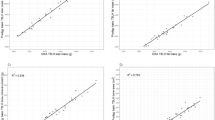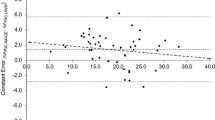Abstract
Objective:
This study was undertaken to validate the first quantitative nuclear magnetic resonance (QMR) instrument designed and built to assess body composition in children from birth to adulthood (up to 50 kg).
Design:
A total of 50 pigs weighing between 3.0 and 49.1 kg were studied. Each piglet's body composition was assessed by quantitative nuclear magnetic resonance (QMR, EchoMRI-AH small), whole-body chemical carcass analysis for lipid and water content, and dual-energy X-ray absorptiometry (DXA, Hologic QDR 4500, using infant or adult whole-body scan acquisition programs where appropriate). Twenty-five piglets (3.1–47.2 kg) were randomly selected to calibrate the QMR instrument. The remaining 25 piglets (3.0–49.1 kg) were used to validate the instrument.
Results:
The precision of QMR to estimate fat mass (FM), fat-free mass (FFM) and total body water (TBW) for five consecutive scans was excellent (1.3, 0.9 and 0.9%, respectively). QMR measures of FM were highly and significantly correlated with chemical carcass analyses and DXA measures (r2=0.99 and r2=0.98, respectively). QMR and DXA FFM results were highly correlated (R2=0.99, P<0.01). TBW measures were strongly correlated between QMR and carcass analyses (R2=0.99, P<0.01). QMR overestimated FM by 2% and DXA measures (using the infant and adult scan programs) overestimated FM by 15% on average.
Conclusion:
QMR provides precise and accurate measures of FM, FFM and TBW in piglets weighing up to 50 kg. As the piglet is considered to be an excellent model of human development, these data suggest that QMR should provide the opportunity to acquire valuable body composition data in longitudinal studies in children, which is not possible or practical with other commercially available instrumentation.
This is a preview of subscription content, access via your institution
Access options
Subscribe to this journal
Receive 12 print issues and online access
$259.00 per year
only $21.58 per issue
Buy this article
- Purchase on Springer Link
- Instant access to full article PDF
Prices may be subject to local taxes which are calculated during checkout



Similar content being viewed by others
References
Koletzko B, Girardet JP, Klish W, Tabacco O . Obesity in children and adolescents worldwide: current views and future directions—working group report of the first world congress of pediatric gastroenterology, hepatology, and nutrition. J Pediatr Gastroenterol Nutr 2002; 35 Suppl 2: S205–S212.
Ogden CL, Carroll MD, Flegal KM . High body mass index for age among US children and adolescents, 2003–2006. JAMA 2008; 299: 2401–2405.
Wells JC, Chomtho S, Fewtrell MS . Programming of body composition by early growth and nutrition. Proc Nutr Soc 2007; 66: 423–434.
Urlando A, Dempster P, Aitkens S . A new air displacement plethysmograph for the measurement of body composition in infants. Pediatr Res 2003; 53: 486–492.
Ellis KJ, Yao M, Shypailo RJ, Urlando A, Wong WW, Heird WC . Body-composition assessment in infancy: air-displacement plethysmography compared with a reference 4-compartment model. Am J Clin Nutr 2007; 85: 90–95.
Fields DA, Higgins PB, Radley D . Air-displacement plethysmography: here to stay. Curr Opin Clin Nutr Metab Care 2005; 8: 624–629.
Ittenbach RF, Buison AM, Stallings VA, Zemel BS . Statistical validation of air-displacement plethysmography for body composition assessment in children. Ann Hum Biol 2006; 33: 187–201.
Davis JA, Dorado S, Keays KA, Reigel KA, Valencia KS, Pham PH . Reliability and validity of the lung volume measurement made by the BOD POD body composition system. Clin Physiol Funct Imaging 2007; 27: 42–46.
Wagner DR, Heyward VH, Gibson AL . Validation of air displacement plethysmography for assessing body composition. Med Sci Sports Exerc 2000; 32: 1339–1344.
Fields DA, Hunter GR, Goran MI . Validation of the BOD POD with hydrostatic weighing: influence of body clothing. Int J Obes Relat Metab Disord 2000; 24: 200–205.
Koo WW, Hammami M, Shypailo RJ, Ellis KJ . Bone and body composition measurements of small subjects: discrepancies from software for fan-beam dual energy X-ray absorptiometry. J Am Coll Nutr 2004; 23: 647–650.
Shypailo RJ, Butte NF, Ellis KJ . DXA: can it be used as a criterion reference for body fat measurements in children? Obesity 2008; 16: 457–462.
Elowsson P, Forslund AH, Mallmin H, Feuk U, Hansson I, Carlsten J . An evaluation of dual-energy X-ray absorptiometry and underwater weighing to estimate body composition by means of carcass analysis in piglets. J Nutr 1998; 128: 1543–1549.
Membrez M, Blancher F, Jaquet M, Bibiloni R, Cani PD, Burcelin RG et al. Gut microbiota modulation with norfloxacin and ampicillin enhances glucose tolerance in mice. FASEB J 2008; 22: 2416–2426.
Pearsall S, Wachtman L, Mansfield K, Lane J, Seehra J . An investigative pharmacology study of a GDF-8 (myostatin) inhibitor, ACE-031, in the common marmoset (Callithrix Jacchus). FASEB J 2008; 22: 1137.
Reidelberger RD, Haver AC, Chelikani PK, Buescher JL . Effects of different intermittent peptide YY (3-36) dosing strategies on food intake, body weight, and adiposity in diet-induced obese rats. Am J Physiol Regul Integr Comp Physiol 2008; 295: R449–R458.
Shankar K, Harrell A, Liu X, Gilchrist JM, Ronis MJJ, Badger TM . Maternal obesity at conception programs obesity in the offspring. Am J Physiol Regul Integr Comp Physiol 2008; 294: R528–R538.
Napolitano A, Miller SR, Murgatroyd PR, Coward WA, Wright A, Finer N et al. Validation of a quantitative magnetic resonance method for measuring human body composition. Obesity 2007; 16: 191–198.
Mitchell AD, Scholz AM, Wange PC, Song H . Body composition analysis of the pig by magnetic resonance imaging. J Anim Sci 2001; 79: 1800–1813.
Leymaster KA . Tomography to estimate changes in body tissues. J Anim Sci 1986; 63: 89–95.
Mitchell AD, Scholz AM, Conway JM . Body composition analysis of small pigs by dual-energy X-ray absorptiometry. J Anim Sci 1998; 76: 2392–2398.
Ellis KJ, Shypailo RJ, Pratt JA, Pond WG . Accuracy of dual-energy X-ray absorptiometry for body-composition measurements in children. Am J Clin Nutr 1994; 60: 660–665.
Brunton JA, Bayley HS, Atkinson SA . Validation and application of dual-energy X-ray absorptiometry to measure bone mass and body composition in small infants. Am J Clin Nutr 1993; 58: 839–845.
Mitchell AD, Steele NC, Solomon MB, Alila HW, Lindsey TO, Cracknell V . Influence of dietary background on the response of pigs to the beta-adrenergic agonist BRL 47672. J Anim Sci 1994; 72: 1516–1521.
Folch J, Lees M, Stanley GHS . A simple method for the isolation and purification of total lipids from animal tissues. J Biol Chem 1957; 226: 497–509.
Butte NF, Wong WW, Hopkinson JM, Heinz CJ, Mehta NR, Smith EO . Energy requirements derived from total energy expenditure and energy deposition during the first 2 y of life. Am J Clin Nutr 2000; 72: 1558–1569.
Fomon SJ, Haschke F, Ziegler EE, Nelson SE . Body composition of reference children from birth to age 10 years. Am J Clin Nutr 1982; 35: 1169–1175.
Ellis KJ . Evaluation of body composition in neonates and infants. Semin Fetal Neonatal Med 2007; 12: 87–91.
Speiser PW, Rudolf MC, Anhalt H, Camacho-Hubner C, Chiarelli F, Eliakim A et al. Childhood obesity. J Clin Endocrinol Metab 2005; 90: 1871–1887.
Rigo J . Body composition during the first year of life. Nestle Nutr Workshop Ser Pediatr Program 2006; 58: 65–76.
Fuller NJ, Dewit O, Wells JC . The potential of near infrared interactance for predicting body composition in children. Eur J Clin Nutr 2001; 55: 967–972.
Fogelholm M, van Marken LW . Comparison of body composition methods: a literature analysis. Eur J Clin Nutr 1997; 51: 495–503.
Ong KK, Ahmed ML, Sherriff A, Woods KA, Watts A, Golding J et al. Cord blood leptin is associated with size at birth and predicts infancy weight gain in humans. ALSPAC study team. Avon longitudinal study of pregnancy and childhood. J Clin Endocrinol Metab 1999; 84: 1145–1148.
Liao XP, Zhang WL, He J, Sun JH, Huang P . Bone measurements of infants in the first 3 months of life by quantitative ultrasound: the influence of gestational age, season, and postnatal age. Pediatr Radiol 2005; 35: 847–853.
Moyer-Mileur LJ, Quick JL, Murray MA . Peripheral quantitative computed tomography of the tibia: pediatric reference values. J Clin Densitom 2008; 11: 283–294.
Binkley TL, Specker BL . pQCT measurement of bone parameters in young children: validation of technique. J Clin Densitom 2000; 3: 9–14.
Littner Y, Mandel D, Mimouni FB, Dollberg S . Bone ultrasound velocity curves of newly born term and preterm infants. J Pediatr Endocrinol Metab 2003; 16: 43–47.
Ma G, Yao M, Liu Y, Lin A, Zou H, Urlando A et al. Validation of a new pediatric air-displacement plethysmograph for assessing body composition in infants. Am J Clin Nutr 2004; 79: 653–660.
Yao M, Nommsen-Rivers L, Dewey K, Urlando A . Preliminary evaluation of a new pediatric air displacement plethysmograph for body composition assessment in infants. Acta Diabetol 2003; 40 Suppl 1: S55–S58.
Sainz RD, Urlando A . Evaluation of a new pediatric air-displacement plethysmograph for body-composition assessment by means of chemical analysis of bovine tissue phantoms. Am J Clin Nutr 2003; 77: 364–370.
Wagner DR, Heyward VH . Techniques of body composition assessment: a review of laboratory and field methods. Res Q Exerc Sport 1999; 70: 135–149.
Blake GM, Naeem M, Boutros M . Comparison of effective dose to children and adults from dual X-ray absorptiometry examinations. Bone 2006; 38: 935–942.
Tinsley FC, Taicher GZ, Heiman ML . Evaluation of a quantitative magnetic resonance method for mouse whole body composition analysis. Obes Res 2004; 12: 150–160.
Author information
Authors and Affiliations
Corresponding author
Ethics declarations
Competing interests
The authors declare no conflict of interest.
Rights and permissions
About this article
Cite this article
Andres, A., Mitchell, A. & Badger, T. QMR: validation of an infant and children body composition instrument using piglets against chemical analysis. Int J Obes 34, 775–780 (2010). https://doi.org/10.1038/ijo.2009.284
Received:
Revised:
Accepted:
Published:
Issue Date:
DOI: https://doi.org/10.1038/ijo.2009.284
Keywords
This article is cited by
-
An Adjustable TD-NMR Method for Rapid and Quantitative Analysis of Body Composition in Awake Mice
Applied Magnetic Resonance (2020)
-
Body composition during fetal development and infancy through the age of 5 years
European Journal of Clinical Nutrition (2015)
-
Quantitative Nuclear Magnetic Resonance to Measure Fat Mass in Infants and Children
Obesity (2011)



